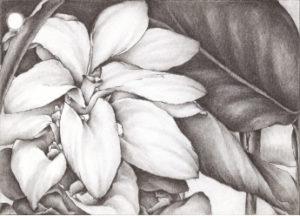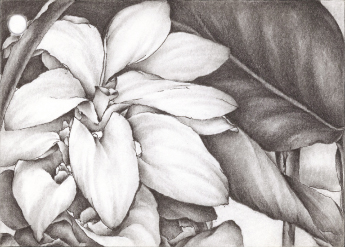Last updated on April 6, 2018

Two Cabrillo art instructors, each a master of their respective crafts, set out on a journey of curiosity and discovery around the world. Their “Findings” were on display at the Cabrillo Gallery on the Aptos campus, located under the library.
You might have passed by it more than just a few times walking to your next class— unless you happen to be an art student, in which case its presence is probably well-known. The Cabrillo Art Gallery has been recognized as one of the finest show spaces to occupy itself on a community college throughout the state.
On February 8, 2018, the gallery held a reception exhibiting the works of Dawn Nakanishi and Rebecca Ramos. The two educators, whose artistic endeavors began decades ago, were featured together in the spring semester’s gallery opening under one theme, “Findings,” made up of the work they discovered on sabbatical.
A sabbatical can be explained as an exploration of the world and oneself within it—that’s the poetic way of phrasing it. On sabbatical, teachers are granted a paid leave so they may further research their field of study, in the field. A college will do this to ensure its educators and curriculum are up to date with the world.
During their “Findings,” Nakanishi and Ramos traveled around the globe and dug up their roots, revealing heritages not so long-forgotten. Nakanishi, whose expedition took her to Japan, said, “I would probably say that the theme in my art is taking things from nature, trying to think of things in terms of universal communication and beauty. The Japanese have a term, ‘wabi-sabi,’ which is the beauty of imperfection, or the beauty of things that are impermanent.
“In Japanese culture, the beauty of something that’s fleeting, like the cherry blossom, time, or when all our Japanese Maples turn fiery red, there’s a beauty and value put on things that are gorgeous for a certain amount of time, and then they disappear. . . so, you know, I’m trying to do things that capture the moment, invite people to stop what they’re doing and look, or invite them to touch.
Ramos, who specializes in the fine art of printmaking and life-drawing, found herself hiking through the tropics of Hawaii, keeping her journal handy as she navigated the cragged coastline.
Ramos explained her relationship with the islands; “Hawaii definitely formed my cultural identity in a sense that there’s an incredibly integrated relationship between people and natural phenomenon, natural forces, natural forms—land actually holds all sorts of facets of someone, whether it’s their genealogy, their geography, religion, their rituals, language.”
She shares with us her reasons for being there, and where she intended to lead her focus when she left the school campus and set out for adventure. Explaining how, “the plants that were surveyed in the 1840s from Hawaii, when they were surveyed in the US exploring Expedition, no contextual, cultural contextual, information was retained.”
Ramos set out documenting the rare and endemic flora that found itself scattered among the flock of land masses that make up Hawaii. Her goal: “to redraw the plants that they surveyed in the 1800s and then add the context for the plants in terms of their Hawaiian names and their use, and now, they’re conservation status.”
Ramos said, “my focus was to underscore, for students, what they could do with their own passion and what they could do within drawing and contemporary printmaking to continue that relationship between what an artist can do in culture and society — and that is communicate.”
A similar message emerged in the interviews with Nakanishi and Ramos, yielding hope for the fearful wannabe artist who lives within us all.
“Learn as much as you can and don’t worry. . . and talk to people! When I was trying tofigure out whether I wanted to go into business, or whether I wanted to go into education— I knew that I wanted to teach —I knew that I could run a business, so I talked to alot of people, and most people are very open to share with you their path, how they got where they were, and how much they like what they’re doing. That’s part of being creative.” —Nakanishi
“Everything will have its challenges. However, if you follow your passion, your passion will help you sustain the super hard times. . . but, if you follow something, if you do something that’s not your passion, the question is— What will sustain you through those difficult times?” —Ramos
From their journeys, Instructors Ramos and Nakanishi each brought back something new of old.
For Ramos, it was her discovery of the near-forgotten silverpoint technique— a method that uses a filed shard of silver as a stylus, producing delicate, smudge-free, lines. During her speaking at the gallery, she said that this practice can capture the ephemeral process of life escaping the body. Ramos succeeded in
this litteral “seizing of the moment” when she documented the local Hawaiian plants in her pocket-sized journal.
Nakanishi had a similar experience when she found the art of Mokume-gane. Mokume, the Japanese term for “wood-eye” or “wood-grain”, and gane, for metal, describes the aesthetic of this art style. Layered pieces of metal are masterfully fused together in the forge, producing what one could describe as a “controlled” marbled effect.
Nakanishi demonstrated this in the piece she was most proud of — a Mokume-gane jellyfish.
Laminated strips of copper and steel came together in this creation, titled the “Monterey Current.” It was Nakanishi’s intention for this metal-jelly to bring a piece of the California coast back to Japan

